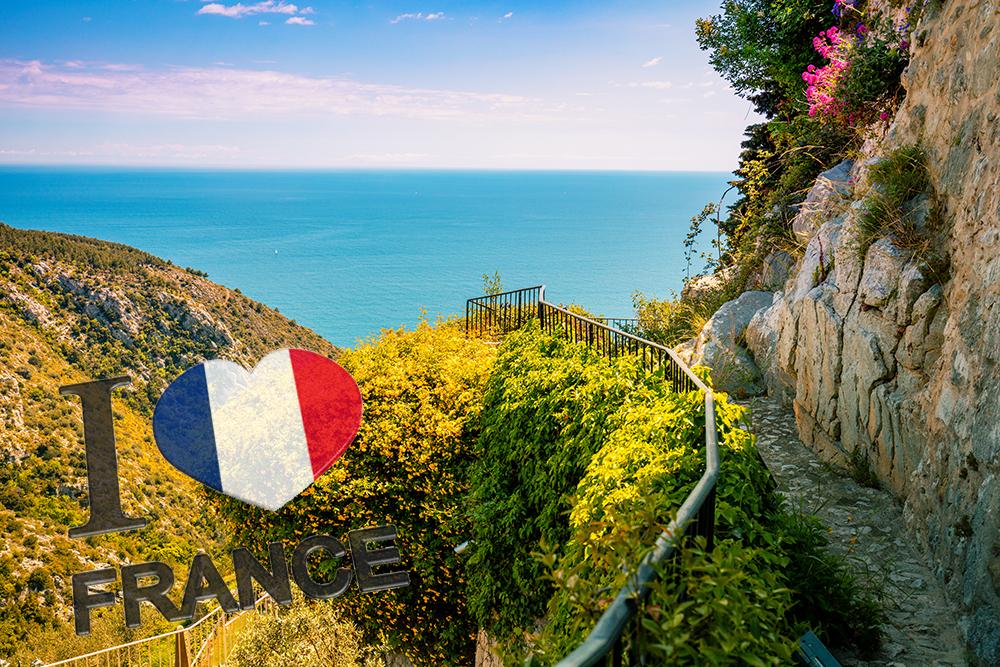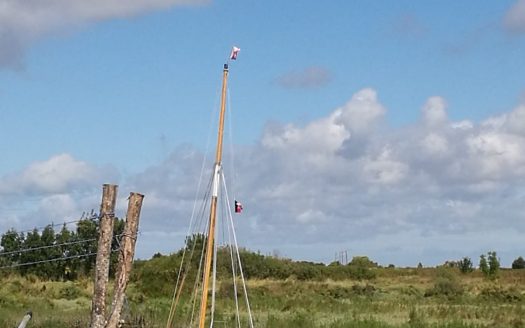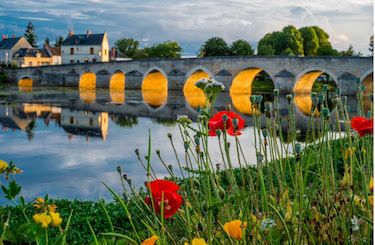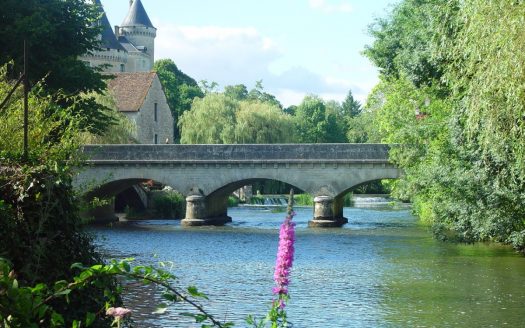
10 Places In France Off The Beaten Track
All of France is wonderful and offers a huge diversity of landscape but little beats the enjoyment of hidden treasures that are not on the regular tourist trail. Some of the places I have chosen will be busy in the summer months, but mainly with French visitors. However, if you can take your holidays in France during the quieter months your visit to these lesser known places will show you some of the best that France has to offer
Chausey Islands, Normandy, France
Chausey is unique in Europe but remains relatively unknown to outsiders. This magical archipelago off the coast of Normandy France, consists of 365 little islands at low tide and 52 at high tide. It is 17km from the mainland with boats departing from Granville and arriving at Le Grande Ile in less than an hour. The Grande Ile is the only inhabited island and is 1.5km long and 50m wide at high tide. In the summer there is a restaurant and a couple of little shops but most things close down for the winter. Worth seeing are the pretty Chapel, a lighthouse and a fort plus the little fishing village.

The variation between high and low tide is up to 14 metres, roughly the height of a four-storey building. Even more amazing, while only 65 hectares of land stand above the water at high tide, 40 sq kms are revealed by the lowest tides which enlarges the area 100 times! If you plan to enjoy some magnificent walks at low tide do check tide tables carefully before you head off.
Chausey is an elating, unforgettable and magically changing place to visit.
Rochemenier Village Troglodytique, Loire
Troglodite cave homes fascinate me and they exist in parts of France wherever the truffeau stone was excavated to create the magnificent buildings of Paris and other cities. My favourite to visit is the village of Rochemenier, near Saumur in the Loire Valley France, which has retained the caves as they would have been used originally (in other places they have been sold off as quirky holiday homes).

On arrival you enter the honeycomb of caves created around a central pit. There are barns, wine cellars and stables as well as homes, equipped with original rustic furniture, bread ovens with carved stone seats and little cubby holes for pots and pans. The tiny, very dark bedrooms have snug little alcoves dug out for beds. When a new child was born the family simply carved another hole in the wall. Down a winding tunnel is the underground chapel with painstakingly carved arches and niches dug out for statues. A larger room provided space for the entire village to congregate for the veilloirs, long winter evenings spent making baskets, spinning flax, and pressing walnuts, singing, even clog dancing, all underground.
At Rochemenier it is easy to image the lives of the cave dwellers and romantic as it looks, it always feels good to get back into the sunlight!
The Marais-Poitevin, Pays-de-la-Loire, France

This is a region of marshes, canals and rivers which have been reclaimed from the sea as it retreated. Although you can see much of the area from the little roads that criss-cross it, there is no doubt that to explore these special waterways at their best they must be seen from a boat. Exploring by boat provides easy access to the still green waters as you glide past river banks teeming with life all of which you can see at eye-level. Frogs, herons and dragonflies are easy to spot and the sound of the birdsong accompanying the gentle dipping of your oars into the green water provides all the relaxation anyone could ask for. The shade of the tall poplars and weeping willows is much appreciated in the summer months as is some insect repellent!
Flat bottom boats, known as ‘barques’ can be hired from most of the canalside villages. You can choose to have a guide to take you through the maze of waterways or you can hire your own boat or canoe and head off for an exploratory trip armed with a map. Unfortunately, like most places nowadays the area can be busy in the high season but treating yourself to a day of lazing around on these tree lined canals and rivers in spring or autumn is an experience you won’t forget.
Talmont-sur-Gironde, Charente-Maritime, France
Talmont is one of my favourite small villages in Poitou Charentes, but do visit out of the busy holiday season. Being only 15 km south of Royan it attracts French tourists in the summer months and is really too small for its sense of serenity to be stay intact.

The joy of Talmont is the peace and simplicity which it exudes out of the busy season. May and June are my favourite months in this area of France, when I can wander through the little lanes and enjoy the array of hollyhocks swaying in the sea breeze when they are not protected by the walls of the little whitewashed houses with their blue shutters
Other than enjoying a stroll along the little streets, with charming small restaurants and shops selling local handmade arts and crafts, there is little to see in Talmont other than the church of St. Radegonde which sits on a grassy headland. Once you arrive at the church you are likely to recognise it as it is one of the most used images on tourist information.
The tiny museum telling the story of the church and the local fishing industry is worth a visit. It is small, simple and traditional, just like everything at Talmont.
Angles-sur-Anglin, Vienne, France
This mediaeval village is one of the “Plus Beaux Villages de France” and is chocolate box pretty. Angles sur Anglin has several features that make it a special village, not least of which is its lovely riverside setting, with elegant buildings and beautiful views as you gaze upwards to the ruined castle on the hilltop opposite. Enjoying a picnic on the riverbanks in the shade of one the lovely old trees is an experience not to be forgotten. There is something lazy and elegant about life in this little village.

The village is divided into an upper and lower village which are connected by 100 steps! The old parts of the upper village are typically mediaeval and bursting with charm and interest, having the quaint little streets and alleyways so evocative of this period.
There are a few restaurants and shops and a weekly market. Everywhere is beautifully green interspersed with the colour of well kept gardens and hanging baskets. The Château is in ruins but it’s well worth climbing the hill to see the remains of the chapel and dungeon and the Romanesque church which makes a cool place to sit calmly and realise how wonderful life is in such a lovely village.
A visit to this little medieval village in the heart of such beautiful countryside cannot possibly disappoint anyone.
Gouffre de Padirac, Dordogne, France
The magical and mysterious caves at Padirac are situated close to Rocamadour, another favourite destination in the area and just across the border into Lot. It’s worth visiting the village of Rocamadour while on your way to the caves. Here the houses all cling to the rock face hanging over the river below; the little streets are narrow and steep and you certainly won’t have seen anything like this in the U.K.

However, for me it’s the caves at Padirac that are so very special. They are approached via a great chasm about 99 metres around the rim and you descend 75 metres to enter the cave system. After the initial descent you need a boat to explore the caves. This is an eerie trip along subterranean streams passing through various underground caverns, each different and each special and all full of extraordinary rock formations. It’s dark, damp and not for the faint hearted! However, the memory of my visit to these caves remains with me more than any caves I have ever visited.
Plage de l’Espiguette, Languedoc-Roussillon, France
This must be the wildest beach in France. In the height of summer it attracts tourists in search of a natural environment away from the usual beach attractions but out of season you can have the 8 kms of beach nearly to yourself. It is situated in the Carmargue area of Languedoc Rousillon France, the region of cowboys, black bulls, white horses and flamingos languishing in the lagoons so even the journey to this beach is really special.
The golden sands are backed by sand dunes and the only building to be seen for the whole length of the wide beach is the little white lighthouse. The road ends at the car park and as you head for a walk or to search for a lonely spot you may need to avoid a few naturists enjoying the solitude this wild beach offers.
The Mediterranean laps the sandy shoreline of this area of France, although in places the width of the beach makes it a reasonable walk before you can plunge into the warm, azur blue sea.
This is my favourite winter beach destination; wild and deserted, just how a beach should be. However, a summer night time barbecue is also hard to beat!
Ille-sue-Tête-à-tête, Pyrénées Orientales
The reason for this visit is not to see the town, which is interesting enough, but to see the nearby amazing rock formations. The town itself has interesting ramparts, gateways, walls and towers these fortifications being necessary because of its proximity to the Spanish border.

The ‘orgues de Ille sur Têt, situated about 2 kms from the town, are a most impressive sight. You park a short distance away from them and as you walk up the grassy track you cannot fail to be amazed. At every step you get a different, startling view. The natural amphitheatre at the centre is made up of many tall pillars which have been naturally eroded by the weather turning the white rock into shapes reminiscent of organ pipes. These pipes rise up to 12 metres but each year a little more is eroded and shapes change. Although they are named after organ pipes local people tend to refer to them as fairy chimneys. When you stand amongst them you can sense the mystery they give to the landscape.
Goudargues, Gard, Languedoc-Roussillon
The lovely little canalside village of Goudargues is a peaceful place to wander and relax. Despite it being referred to as the Venice of Gard for me it’s charm does not lie in any similarity to that busy and sometimes smelly city, but it’s peace and the feeling you get that the world has almost stopped still. Goudargues is situated close to Uzès, the famous medieval town which attracts lots of summer tourists with its elegant architecture, shops and restaurants. However, Goudargues is also a million miles away from the sophistication of Uzès and revels in the simple French life it holds on to. Little café terraces line the canal and across the road are shops selling local produce and a few smarter restaurants all enjoying the shade of the magnificent plane trees. Whatever time of year you choose to visit this village you will be entranced by its beauty and peace.

Leaving the canal you come across the well restored laverie and a small path alongside the allotments which leads down to the River Cèze. Here you can swim from the little beaches or just sit and watch the occasional canoeist paddling gently downstream. Enjoy a nice French picnic down by the river after an aperitif along the canal. Does life get any better?
St. Valentine’s day in Roquelaure, Languedoc Roussillon, France
Not a place this time, so much as an event. For a century and a half, Roquemaure has been celebrating Saint Valentine’s day. Every two years on the weekend closest to February 14th Roquemaure becomes the ‘city of love’.
The little town on the banks of the River Rhône returns to the 19th century to commemorate the arrival of the relics of Saint Valentine in 1868 with more than 800 people dressed in period costumes, horse-drawn carts and bustling market stalls. Each shop window is decorated in the fashion of 1868 and all the buildings are clothed in mimosa and violets. Every villager is dressed in traditional costumes as they promenade through the market square or work in the streets of the small town. The hairdresser shop turns into a wig maker, the pharmacist returns to being an apothecary, there is the knife grinder, the chair caner, pedlars, cobblers, basket makers – in fact every traditional craft is represented and showing off their craft. Beautifully dressed parents push prams from the turn of the century with babies appropriately dressed and children in full costume run by their side as they head to some of the many stalls selling old fashioned sweets and local produce.
To the sound of the oboes and bagpipes, the tambourines and flutes, folklore groups, along with street performers, jugglers and acrobats, liven up the old village and it is only the presence of modern day visitors who remind you that you are not living 150 years ago. 2019 is the year to enjoy this amazing Provençal festival.





